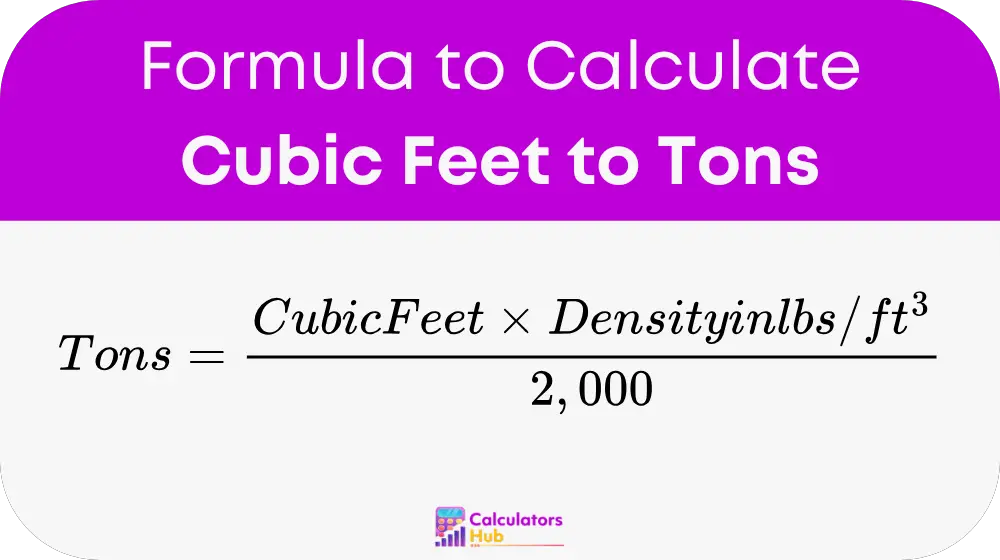A Cubic Feet to Tons Calculator is a tool used to convert volume (cubic feet) into weight (tons) based on the density of the material. This is essential for construction, landscaping, shipping, and industrial applications, where knowing the material’s weight is necessary for transportation, storage, and structural planning.
Since different materials have different densities, the conversion between cubic feet and tons depends on the material’s mass per unit volume. This calculator simplifies the process by allowing users to input a material's volume in cubic feet and determine its equivalent weight in tons.
Formula of Cubic Feet to Tons Calculator
The conversion from cubic feet to tons is based on the density of the material, expressed in pounds per cubic foot (lbs/ft³).
Formula to Convert Cubic Feet to Tons:

Where:
- Cubic Feet is the volume of the material.
- Density in lbs/ft³ is the material's weight per cubic foot.
- 2,000 is the number of pounds in a ton (since 1 ton = 2,000 pounds).
This formula ensures accurate conversion between volume and weight for different materials.
Pre-Calculated Conversion Table for Common Materials
To help users quickly reference common materials, here is a conversion table based on standard densities:
| Material | Density (lbs/ft³) | 1 ft³ to Tons |
|---|---|---|
| Sand (Dry) | 100 - 105 | 0.05 - 0.0525 |
| Sand (Wet) | 120 - 130 | 0.06 - 0.065 |
| Gravel | 95 - 120 | 0.0475 - 0.06 |
| Limestone | 150 | 0.075 |
| Concrete | 145 | 0.0725 |
| Asphalt | 140 | 0.07 |
| Dirt (Loose) | 75 - 100 | 0.0375 - 0.05 |
| Mulch (Wood) | 20 - 30 | 0.01 - 0.015 |
| Steel | 490 | 0.245 |
This table helps construction workers, landscapers, and engineers quickly estimate tons based on cubic feet measurements.
Example of Cubic Feet to Tons Calculator
Let’s calculate the weight in tons for 500 cubic feet of gravel, assuming an average density of 110 lbs/ft³.
Given:
- Cubic Feet = 500 ft³
- Density of Gravel = 110 lbs/ft³
Applying the formula:
Tons = (500 × 110) / 2,000
Tons = 55,000 / 2,000 = 27.5
So, 500 cubic feet of gravel weighs 27.5 tons.
Now, let’s determine how many cubic feet are in 10 tons of dry sand, assuming an average density of 102 lbs/ft³.
Rearranging the formula:
Cubic Feet = (Tons × 2,000) / Density
Cubic Feet = (10 × 2,000) / 102 ≈ 196 ft³
So, 10 tons of dry sand occupy approximately 196 cubic feet.
Most Common FAQs
Density determines how much mass is contained in a given volume. Since different materials have different densities, the conversion varies based on the material type.
Yes, as long as the density of the material is known, the calculator can convert cubic feet to tons accurately.
The accuracy depends on the density value used. Some materials, like gravel, sand, and dirt, have density variations due to moisture content and compaction.